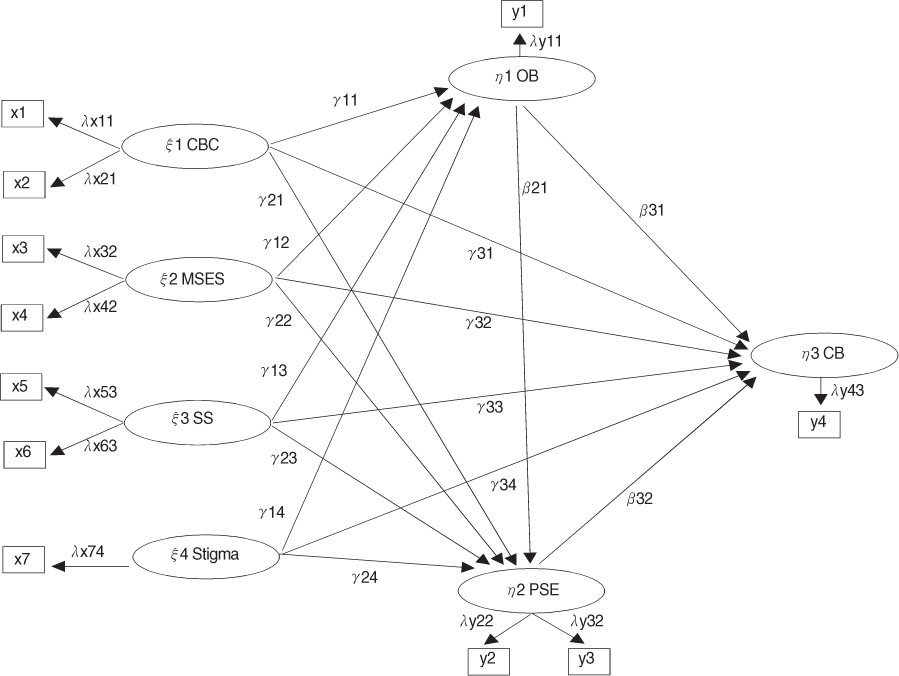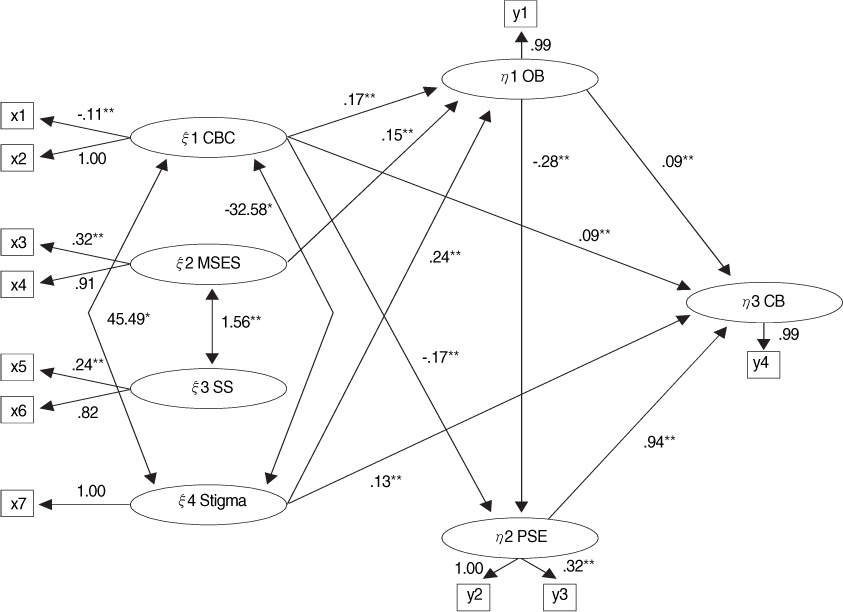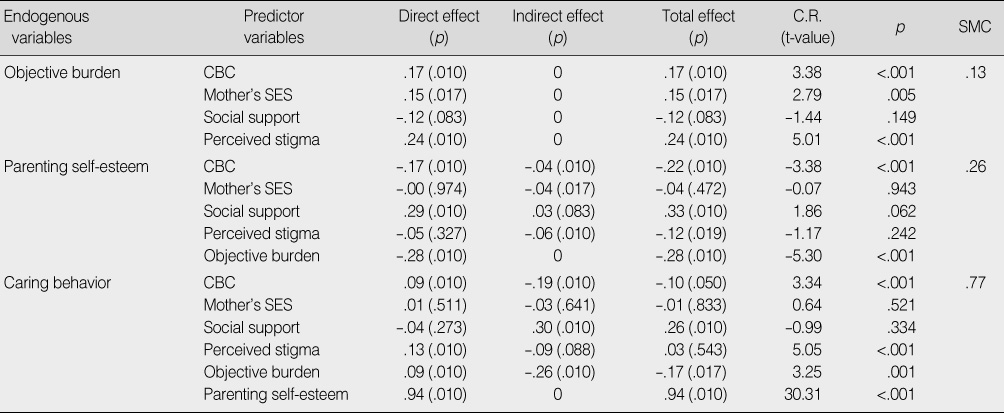Articles
- Page Path
- HOME > J Korean Acad Nurs > Volume 39(5); 2009 > Article
-
Original Article
- A Structural Model of Caring Behavior of Mothers of Disabled Children
- Ae-Ran Lee
-
Journal of Korean Academy of Nursing 2009;39(5):673-682.
DOI: https://doi.org/10.4040/jkan.2009.39.5.673
Published online: October 31, 2009
Professor, Department of Nursing, Wonkwang Health Science College, Iksan, Korea.
- Address reprint requests to: Lee, Ae-Ran. Department of Nursing, Wonkwang Health Science College, 344-2 Sinyong-dong, Iksan 570-750, Korea. Tel: 82-63-840-1315, Fax: 82-63-840-1319, arlee@wkhc.ac.kr
Copyright © 2009 Korean Society of Nursing Science
Abstract
-
Purpose
- This study was done to develop a model which explains factors influencing caring behavior of mothers who have children with disabilities, and to verify the appropriateness of the model and the relationship among variables.
-
Methods
- The participants in the research were the mothers who had a 3 to 12 yr-old children with disabilities. The data were collected from 451 mothers through self-reported questionnaires from July 14 to 31, 2008. A total of the 371 data sets were analyzed using SPSS/WIN 11.5 and AMOS 5.0 version.
-
Results
- The children's behavior characteristics, social support, objective burden and parenting self-esteem had an impact on the mothers' caring behavior. Especially, parenting self-esteem including parenting satisfaction and self-efficacy was the most influential factor. These variables explained 77% of the mothers' caring behavior for these children.
-
Conclusion
- The results suggest that some strategies for promoting mothers' parenting self-esteem focused on parenting satisfaction and self-efficacy should be developed in order to help mothers in caring for their child who is disabled.
- 1. Ayyangar R. Health maintenance and management in childhood disability. Physical Medicine Rehabilitation Clinics of North America. 2002;13:793–821.ArticlePubMed
- 2. Bae BR. Structural equation modeling with AMOS 7-principles and practice-. 2007;Seoul, Choungram Books.
- 3. Bandura A. Self-efficacy: The exercise of control. 1997;9th ed. New York, NY, W.H. Freeman and Company.
- 4. Bor W, Sanders MR. Correlates of self-reported coercive parenting of preschool-aged children at high risk for the development of conduct problems. Australian and New Zealand Journal of Psychiatry. 2004;38:738–745.ArticlePubMed
- 5. Branden N. Self-esteem every day: Reflections on self-esteem and spirituality. 1998;New York, NY, Simon & Schuster.
- 6. Eo YS. Effects of empowerment program on burden on mothers having a child with cerebral palsy. 2004;Busan, Pusan National University. Unpublished doctoral dissertation.
- 7. Eyberg SM, Robinson EA. Conduct problem behavior: Standardization of a behavioral rating scale with adolescents. Journal of Clinical Child Psychology. 1983;12:347–354.Article
- 8. Gibaud-Wallson J, Wandersman LP. Development and utility of the Parenting Sense of Competence Scale. Paper presented at the meeting of the American Psychological Association. 1978;Toronto, Canada.
- 9. Harty M, Alant E, Uys CJ. Maternal self-efficacy and maternal perception of child language competence in pre-school children with a communication disability. Child: Care, Health and Development. 2006;33:144–154.Article
- 10. Hassall R, Rose J, McDonald J. Parenting stress in mothers of children with an intellectual disability: The effects of parental cognitions in relation to child characteristics and family support. Journal of Intellectual Disability Research. 2005;49:405–418.ArticlePubMed
- 11. Hastings RP, Symes MD. Early intensive behavioral intervention for children with autism: Parental therapeutic self-efficacy. Research in developmental disabilities. 2002;23:332–341.ArticlePubMed
- 12. Johnston C, Mash EJ. A measure of parenting satisfaction and efficacy. Journal of Clinical Child Pathology. 1989;18:167–175.Article
- 13. Kim CY, Kim SM. RAI-HC Assessment Manual Version 2.0/MDS-HC 2.0. 2000;Seoul, Korea Medical Consulting Co..
- 14. Lee AR. The effects of social capital on the quality of life of a mother who has a child with disabilities: A case study of social networks. 2004;Jeonju, Chonbuk National University. Unpublished master's thesis.
- 15. Lee AR, Craft-Rosenberg M. Ineffective family participation in professional care: A concept analysis of proposed nursing diagnosis. Nursing Diagnosis. 2002;13:5–14.PubMed
- 16. Lee AR, Han KJ. Development of a tool to measure maternal behavior for health promotion for preschool children with disabilities. Journal of Korean Academy of Child Health Nursing. 2007;13:444–453.
- 17. Lee EH, Kim JS. Major effect models of social support and its statistical methods in Korean nursing research. Journal of Korean Academy of Nursing. 2000;30:1503–1520.ArticlePDF
- 18. Lee IO. Development of perceived stigma scale for the person with physical disability. 2007;Seoul, Seoul National University. Unpublished doctoral dissertation.
- 19. Lee JH, Kim HY, Lee JH. A study on maternal stress in rearing children with disabilities and maternal quality of life. Journal of Korean Academy of Child Health Nursing. 2007;13:5–12.
- 20. Lin N, Ye X, Ensel WM. Social support and depressed mood: A structural analysis. Journal of Health and Social Behavior. 1999;40:344–359.ArticlePubMed
- 21. Montgomery RJ, Gonyea JD, Hooyman NR. Caregiving and the experience of subjective and objective burden. Family Relations. 1985;34:19–26.Article
- 22. Nelson AM. A metasynthesis: Mothering other-than-normal children. Qualitative Health Research. 2002;12:515–530.ArticlePubMedPDF
- 23. Nettleton S. Cho HJ . The sociology of health and illness. 1997;Cambridge, Polity Press. (Original work published 1995).
- 24. Park JW. A study on development a scale of social support. 1985;Seoul, Yonsei University. Unpublished doctoral dissertation.
- 25. Registered disable persons data. Korean Statistical Information Service. 2008;06 11 Retrieved September 3, 2008. from http://nsportal.stat.go.kr.htm# National.
- 26. Resident Assessment Instrument-Home Care. InterRAI. 1999;Retrieved May 10, 2008. from http://www.interrai.org/section/view/?fnode=15.
- 27. Sanders MR, Woolley ML. The relationship between maternal self-efficacy and parenting practices: Implication for parent training. Child: Care, Health and Development. 2005;31:65–73.PubMed
- 28. Sim MK. A study on self-esteem, coping type and the quality of life in mothers of handicapped children. Journal of Korean Academy of Nursing. 1997;27:673–682.ArticlePDF
- 29. Song JM. In the parenting stress situation, the effect of social support to parental perceptions of child behavior. 1992;Seoul, Sookmyoung Women's University. Unpublished master's thesis.
- 30. Yang SJ. Stress and adaptation in family with physical disabled children. Journal of Korean Academy of Nursing. 1999;29:238–247.ArticlePDF
REFERENCES



*p<.05; **p<.01.
x1=child's ability in daily living; x2=child's behavior problems; x3=family income; x4=mother's educational level; x5=frequency of contacts with supporters; x6=perceived social support; x7=perceived stigma; y1=objective burden; y2=satisfaction; y3=parenting self-efficacy; y4=caring behavior.
Figure & Data
REFERENCES
Citations

- Factors influencing the caring behaviors of primary family caregivers of older adults with dementia: A cross-sectional study
Da-Mi Kim, Hye-Young Jang
Journal of Korean Gerontological Nursing.2024; 26(2): 146. CrossRef - Structural Equation Modeling for Quality of Life of Mothers of Children with Developmental Disabilities: Focusing on the Self-Help Model
Mi Ran Yang, Mi Yu
Journal of Korean Academy of Nursing.2022; 52(3): 308. CrossRef - Validity and Reliability of the Life Transition Scale in Parents of Disabled Children Across the Life Transition Process
Sun Woo Hong, JinShil Kim, Hwal Lan Bang
Child Health Nursing Research.2020; 26(3): 338. CrossRef - A Review of the Korean Nursing Research Literature with Focus on Quantitative Measurement of Caring
Jeong-Hee Kim, Young Sook Park
Journal of Korean Academy of Community Health Nursing.2018; 29(2): 155. CrossRef - Mothers’ Experiences of Caring for Visually Impaired Children
Sangeun Oh
Child Health Nursing Research.2017; 23(2): 219. CrossRef - Construct Validity of the Life Transition Scale for Parents of Children with Autism
Ae Ran Lee, Sun Woo Hong, Se Jin Ju
Journal of Korean Academy of Nursing.2014; 44(5): 563. CrossRef - Development of a Scale to Measure Life Transition Process in Parents of Children with Autism
Ae Ran Lee, Sun Woo Hong, Se Jin Ju
Journal of Korean Academy of Nursing.2012; 42(6): 861. CrossRef - Life Transition of Mothers of Children with Autism
Ae Ran Lee, Sun Woo Hong, Ji Soo Kim, Se Jin Ju
Journal of Korean Academy of Nursing.2010; 40(6): 808. CrossRef


Figure 1
Figure 2
Correlations Matrix among Measurable Variables
*p<.05; **p<.01.
x1=child's ability in daily living; x2=child's behavior problems; x3=family income; x4=mother's educational level; x5=frequency of contacts with supporters; x6=perceived social support; x7=perceived stigma; y1=objective burden; y2=satisfaction; y3=parenting self-efficacy; y4=caring behavior.
Fitness Statistics of Hypothetical Model and Modified Model
GFI=goodness of fit index; RMSEA=root mean square error of approximation; NFI=normal fit index; CFI=comparative fit index; AGFI=adjusted goodness of fit index; PNFI=parsimonious normal fit index.
Effects of Predictor Variables in the Modified Model
CR=critical ratio; SMC=squared multiple correlations; CBC=child's behavior characteristics; SES=mother's socio-economic status.
* x1=child's ability in daily living; x2=child's behavior problems; x3=family income; x4=mother's educational level; x5=frequency of contacts with supporters; x6=perceived social support; x7=perceived stigma; y1=objective burden; y2=satisfaction; y3=parenting self-efficacy; y4=caring behavior.
GFI=goodness of fit index; RMSEA=root mean square error of approximation; NFI=normal fit index; CFI=comparative fit index; AGFI=adjusted goodness of fit index; PNFI=parsimonious normal fit index.
CR=critical ratio; SMC=squared multiple correlations; CBC=child's behavior characteristics; SES=mother's socio-economic status.
 KSNS
KSNS
 E-SUBMISSION
E-SUBMISSION


 Cite
Cite

